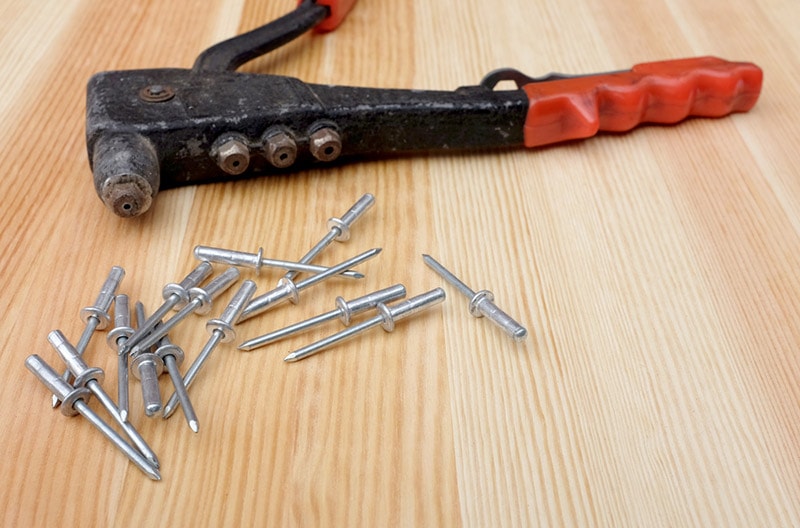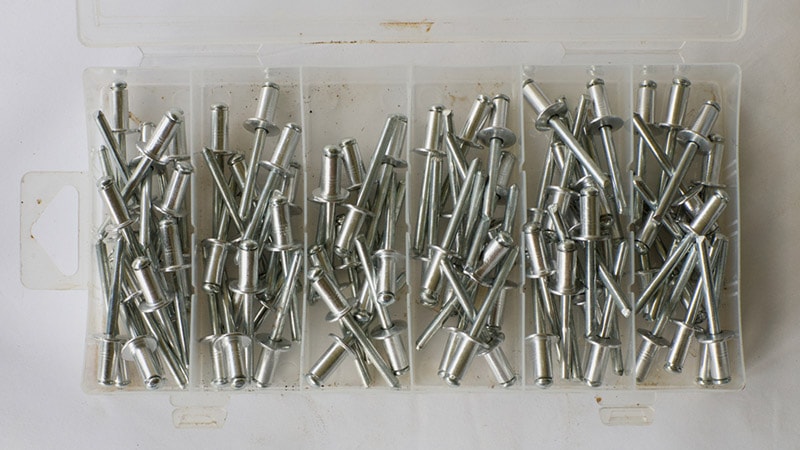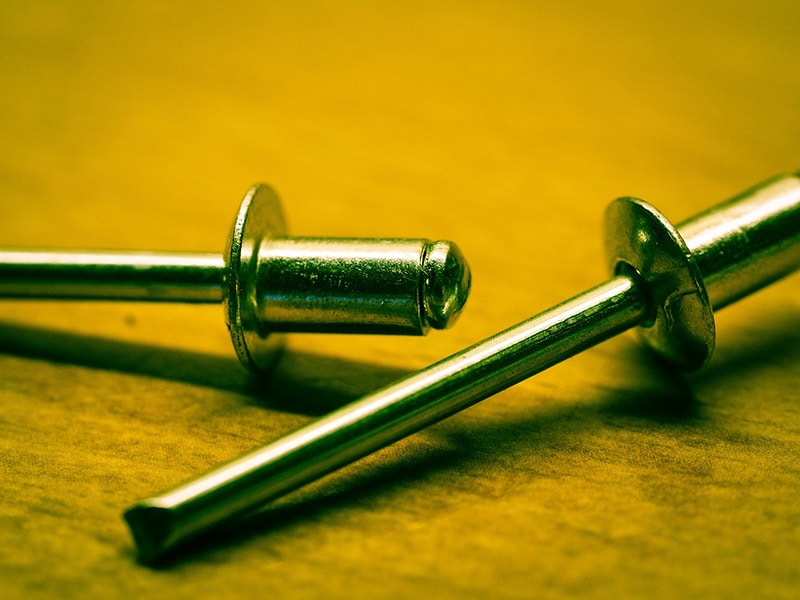How Do Pop Rivets Work? Everything You Need to Know!
-
Codee Chessher
- Last updated:

If you’ve ever inspected a fine piece of metalwork and noticed myriad tiny rivets along the surface, you may have seen pop rivets. They’re an everyday part of industrial, auto repair, and other work all around the globe, but how exactly do those tiny metal rods hold heavy metal together? Let’s find out the answers to that question and more below, including different types of pop rivets and where you might find them.
What Are Pop Rivets and How Do They Work?
At their core, pop rivets are mechanical fasteners like screws, nails, and bolts. The way they work is a smidge more complex, but they offer spectacular results. Pop rivets are commonly made from steel or aluminum, depending on what it’s designed for.
Pop rivets consist of two parts: the mandrel or tail, and the body. First, you put the pop rivet into the slot of a pop rivet gun, tapered side down, and slot the rivet into your pre-drilled hole. In many cases, this will just be two pieces of, say, sheet metal or galvanized metal. When you squeeze the handle of the pop rivet gun, it’s squeezing the rivet’s body.
Not only that, but it’s pulling the body of the rivet through the mandrel. There are two flanges on either side of the mandrel that get pried and forced open when the body is forced through. The two sides get forced open and provide a secure hold.
This creates an effect similar to a screw, but more secure, whereas a screw only has one head, the rivet has two sides of ironclad support. The thin body of the rivet snaps off when the rivet is applied, which requires cleaning up if you’re doing lots of rivets.
Because they’re easy to use and produce a more solid bond than screws, pop rivets are a great way to hold metal together for a long time. Another benefit is that pop rivets are easy to use in cramped spaces that can’t be easily welded, or when you have limited access to the back of your project where the metal surfaces adhere together.

About Pop Rivets
An interesting caveat with pop rivets is that they’re not generally as strong as more industrial rivets like solid rivets. They’re really kind of the superglue of the rivet world. They’re both easy to use and work well enough most of the time. That said, they don’t have the heavy-duty durability of stronger rivets designed to create a permanent joint that can withstand vibrations and other external forces.
Another issue with pop rivets is that you have to consider the materials. Metal is fine, but wood and other brittle, soft materials may be too weak to withstand the rivet. For instance, you could drill your pilot hole, put the rivet in, and then split two pieces of thin plywood when you try to rivet it. Always consider the materials you’re working with and whether pop rivets really are the best fastener for the situation.
This leads us to another notable drawback, which is that pop rivets aren’t water or weatherproof. They have hollow bodies that readily allow moisture and rain to flow in. When you’re joining metal on a roof, for example, that’s a bad thing. When working with pop rivets outdoors, you’ll have to use weatherproof caulking or other weatherproofing products to seal your final results.
Lastly, we must mention that pop rivets aren’t structural fasteners designed for high-stress applications. They’re very thin and heavier rivets offer more structural durability. Consider whether the project is designed to hold weight or withstand vibrations before reaching for the pop rivets.
What Are the Different Types of Pop Rivets?
There are several different types of pop rivets, and each one may work differently than the ‘standard’ blind rivet. We’ll be comparing these types below so you can have a better idea of what they can be used for.
- Open-end: the standard hollow pop rivet used to join surfaces on one side
- Solid: solid pop rivets are more sturdy than hollow rivets and help protect against moisture too, making it perfect outdoors
- Countersunk: similar to open-end, countersunk rivets are designed to sit flush with the surface for a seamless appearance
- Split: AKA grooved rivets, these burrow into softer or brittle materials like wood and drywall but may damage metal
- Peeled blind: uses a larger head to mushroom into a more secure, watertight seal perfect for bonding metal and softer materials
- Multi-grip: these rivets have small indents along the body to help secure metal to plastic or other delicate materials

Where Are Pop Rivets Used?
It may seem like hyperbole, but pop rivets are used nearly everywhere—seriously, check out this exhaustive list of where you’ll find pop rivets in your day-to-day life. If you just look a little closer, you’ll realize they’re on tons of stuff.
- Appliances: used to join metal panels and components together
- Cars: used to join car bodies, engine parts, and panels in place
- Aerospace: used to join everything, from the cabin, engine, seats, and more
- Nautical: more obvious than others, seagoing ships often have tons of bare rivets on display outside and inside
- Electronics: from teeny tiny circuit boards to largish computer cases, rivets are ubiquitous for making our favorite gadgets
- Construction: used to bond metal and other materials where welding, adhesives, or other fasteners are impractical to use
- Home fixtures: seen on cabinets, doorknobs, hinges, and myriad other things across your home
Advantages of Pop Rivets
Pop rivets have a lot of advantages that make them a good choice for bonding two materials together, particularly metal surfaces. Let’s briefly summarize the best qualities that make pop rivets worth using for your next project.
- Stronger bond than adhesives and many fasteners
- Provide an easy way to bond surfaces when one side is inaccessible for any reason
- With prep, easy to apply multiple rivets at a time for larger jobs
- Often more cost-effective than welding or other fastener methods
- Many types are available for different situations and producing different types of seals
- Can be hidden with caulking or other finishing techniques
- Simpler way to bond items of disparate materials, thicknesses, and sizes

Disadvantages of Pop Rivets
Don’t get us wrong: pop rivets are an invaluable tool around any construction site, factory, or workshop. But that doesn’t mean they don’t have some serious disadvantages. Take a look below and weigh them against the pros to see if pop rivets are the fastener for you.
- Requires pre-drilling a pilot hole, which can slow productivity down
- Extremely difficult to remove after the fact
- Some types don’t have a flush finish
- Pop rivets aren’t designed to withstand high-stress or high-temperature conditions
- Some types of rivets can’t be used with softer or more brittle materials like wood
Frequently Asked Questions (FAQs)
How Do I Select the Right Type of Pop Rivet for the Job?
To get that answer, you’ll have to do some math. First, measure the grip range, which is the total thickness of your objects, and therefore the thickness that needs to be clamped together. A longer grip range means you’ll need longer rivets, so always check this before buying any old pop rivets and finding out they’re too short later.
What Do I Need to Install Pop Rivets?
You’ll need a drill with a metal drill bit just a hair smaller than the diameter of your rivet. You want enough wiggle room to slot the rivet’s body in while the head snugly fits in the pilot hole. To do so, you’ll need a pop rivet gun, which is a pretty cheap plastic and metal hand tool easily found in any hardware store. Then the rivets themselves, of course, and make sure to get the appropriate type for the job at hand!
Conclusion
Pop rivets are an efficient way to bond together metal and sometimes wood, requiring just a drill, a rivet gun, and the rivets. They’re not meant to act as a substitute for heavy solid rivets, but pop rivets are a great economical choice for when you just need a secure hold for cheap.
Featured Image Credit: Sarah Marchant, Shutterstock
Contents


